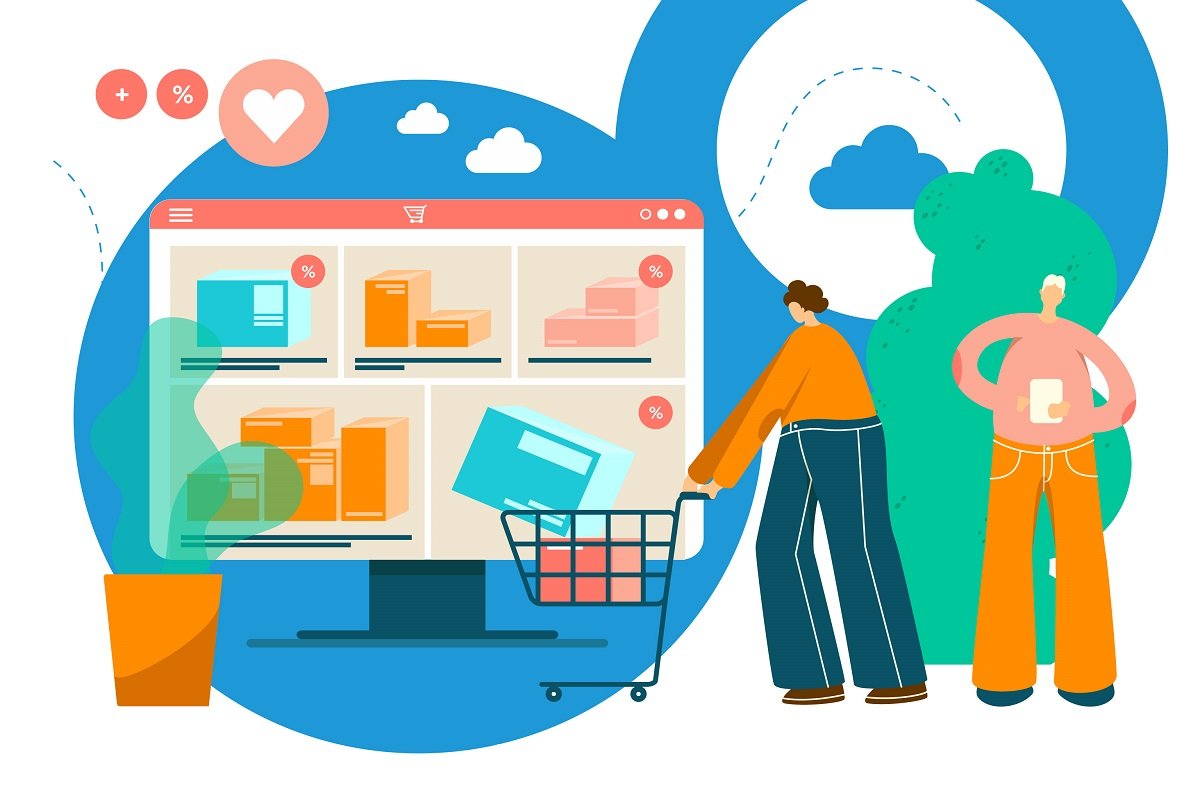Are you engaged in a business that is only active in the neighborhood? Or desire to connect with a wider range of clients but are unsure how? Well, simply creating a website is enough to go global and become successful in the industry. The good news is that creating an eCommerce website or any website for your company to promote products or services is not particularly difficult these days. regardless of how big or small your company is or what sector you work in!
The eCommerce industry is expanding rapidly these days & every day we see more & more retailers shifting to a hybrid method of selling their products both online & offline. In order to create an eCommerce website, there are a lot of prerequisites that are needed to be met. You are not required to manage or code a website when it is being developed. Now that we live in a technological age, it is your obligation to locate the best and most seasoned web development company or an eCommerce website builder that can comprehend your needs and meet them.
Online sales are vital and help you improve your business, whether you are running an online eCommerce tale exclusively or adding internet shopping to an established brick-and-mortar firm. Furthermore, according to recent reports, online shoppers are predicted to outnumber nearly 70% of internet users globally by 2022. As a result, numerous shops are creating a presence in the eCommerce industry or the digital world. In this article, we will discuss, "How to convert a retail store into an eCommerce website?"
Table of Contents
Common Misconceptions About Business & eCommerce Websites
However, it is a difficult step for any retailer or business to develop a successful online store and determine what things to sell. The most widespread misconception regarding business websites is that they must sell products or services, accept credit cards and perform financial transactions, and so on. No! That is not the case. That is their misunderstanding.
While eCommerce websites are taking over the market and the digital world, the great majority of business websites still focus on information rather than purchases. If you want to offer products or services, you should think about creating an eCommerce website.
However, if, like most businesses, your products and services are not meant for Internet sales, you will still require your own web page or website. And you may obtain one quickly and affordably.
Having a web page or business website is about more than simply selling your products, brands, and services - it's also about offering value to potential customers all over the world.
By Following These Steps You Can Convert A Retail Store Into An eCommerce Website
Make your customers aware of your online store
Inform your clients if you have any plans to make it possible for customers to buy your product online or elsewhere without contacting you. Even if you lack the necessary platforms, take some time to plan ahead and let your clients know when they might be able to place an order with you. If you are still working out the details, you might also want to let them know when they can expect to receive more information. You can use your Social Media profiles to spread the information or you can also send them promotional messages through WhatsApp.
Here are some of the best social media marketing techniques to promote your business online.
Create an Online Store
All of your business-to-customer transactions must now be made through online channels. Thankfully, there are many different e-commerce platforms to consider. The best platforms must be chosen, though, based on your requirements. Here's how you can start your own eCommerce website:
- Choose a Domain Name: You must select or register a domain name on the internet before entering the online world. This is where customers may locate the company's website online. The majority of business domain names terminate in ".com," ".net," or ".in." As nearly as feasible, your domain name should correspond to the name of your company. You can purchase a domain from JoonWeb as well.
- Choose a Web Hosting Provider: You will now require a web hosting service to publish your website online so that customers may view it after choosing a domain. Finding a reliable and trustworthy web hosting service provider is not that difficult. Find out if the service provider offers any additional features or services. Make sure your web hosting service will enable adjustments and additions swiftly and affordably so that you can expand and improve your organization in the future.
- Create a Mobile-Friendly Website: Due to the increase in smartphone usage and online buying, having a presence on mobile devices is now more crucial than ever. Your website must be mobile-optimized, which means it must dynamically modify its size and layout to make it easier to use on smaller devices. With the aid of a mobile app development company, you can also create a unique mobile app that users can download from app stores. Websites created on JoonWeb are highly optimized for smartphones.
- Add a Shopping-Cart Software To Your eCommerce Website: If you want to offer products to customers through your eCommerce website, you'll require shopping cart software. With the help of this application, customers will be able to browse the company's inventory to see what's available, choose the products they wish to buy, and eventually make the transaction. However, a lot of shopping cart software alternatives come with tools for managing inventory, configuring shipping, and figuring out taxes. You would be pleased to know that JoonWeb eCommerce websites come with an integrated Shopping cart.
- Set up Payment Methods: eCommerce websites require a merchant service provider to handle their payment process (internet banking, credit & debit card, wallet, visa cards, etc.) because they are unable to take actual cash payments through their websites. You can collect the money by setting up third-party payment processors like PayPal, Stripe, Authorize.net, etc. This service serves as a link between the client, the client's credit card company, and the business. In a small business, the only option for customer payment collection, if neither a payment gateway nor a merchant services provider has been established, is Cash on Delivery.
- Integrate Analytics: Analytics allows you to track user statistics, learn about users' behavior, and get to know users in-depth on your eCommerce website. For instance, if a consumer visits your website, you would be able to learn about how they buy the goods, their transaction history, their buying habits, and the other things they were interested in. Monitoring user behavior is crucial and essential since it helps you raise customer satisfaction and expectations.
- Focus On Marketing & SEO: Every online business has a proven method for luring clients to their websites. You won't be able to quickly turn a sizable profit without a solid plan. Digital marketing choices for your company include SEO, Pay-per-Click (PPC), social media marketing, email marketing campaigns, and more. Links and integration with your social media company pages should be included on your website. By doing this, you can offer to sign people up for electronic newsletters so that you can keep them informed about your most recent goods and services. Luckily for you, JoonWeb is an eCommerce Website Builder that comes with in-built marketing & SEO tools. Click here if you want to learn more about various marketing strategies that can be used to get more visitors to your website.
Still wondering about 'How to Build an Ecommerce Website?" Click here if you want to create an eCommerce website with JoonWeb.
Manage Inventory
You must keep a closer eye on how you handle inventory if you run an internet business. It might not be possible for you to visit your brick-and-mortar store to manage your inventory if you are in a location where a shelter-in-place order is in effect. You might need to employ an off-site warehouse or keep inventory at a private location in this circumstance.
In the end, you must choose whether to accept inventory, where to store it, and how to record it. This is the stage where marketing is involved. Make sure you create a reliable method for tracking inventories and that you are keeping an eye on the price at which these items are being sold (cost of goods sold). Your products must be treated as assets on balance sheets and financial records if they are still in storage. JoonWeb features an in-built easy-to-manage inventory system that can help its users in making changes to their inventory from any location anytime.
Learn more about inventory management here.
Plan How You'll Deliver Goods To Customers
A lot of this may rely on whether you live in a city where shelter-in-place orders are in effect. However, if you reside in a city or state where you are still able to go to your place of employment, you might want to provide curbside pick-up choices for people (this is particularly useful for sellers of perishable goods like food).
- Self-ship the goods: You can send products straight to customers if you have a personal storage facility.
- Coordinate with third-party suppliers: If you have agreements with third-party suppliers or are holding items at an off-site warehouse, you can arrange for them to send products to consumers as they place orders (if they are operational).
- Hire third-party shipping partners: Product deliveries are a common practice for shipping companies like Shiprocket. Their services might help you deliver your goods to customers.
Regardless of the technique you select, make sure to consider your own safety as well as the safety of your staff and clients. You should also adjust your delivery schedule in response to any quarantining statements made by the authorities.
By following the above-mentioned steps you can convert a retail store into an eCommerce website.
In These Changing Times, The Capacity To Adapt Is Crucial
Changing directions is difficult, especially if you have never operated an online business. Fortunately, modern technology developments and the rise of internet shopping have greatly facilitated the shift to e-commerce. So, utilize the aforementioned advice as a springboard to construct a plan for creating a transient or ongoing online business. As you plan your logistics, keep in mind to always be safe and obey the laws in your particular city, county, and state.






